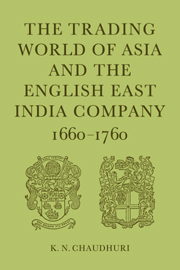Book contents
- Frontmatter
- Contents
- Tables
- Figures
- Maps
- Abbreviations
- Notes on dates, contemporaneous spellings, currency, and weights
- Preface
- Acknowledgements
- 1 The international economy and the East India trade
- 2 A formal theoretical model of the East India Company's trade
- 3 The structure of early trade and the pattern of commercial settlements in Asia
- 4 The evolution of the Company's trading system: operation and policy 1660–1760
- 5 Long-term trends and fluctuations 1660–1760
- 6 Politics of trade
- 7 Markets, merchants, and the Company
- 8 The export of treasure and the monetary system
- 9 The structure of country trade in Asia
- 10 Export of European commodities
- 11 The Company and the Indian textile industry
- 12 The Company's trade in textiles
- 13 Pepper
- 14 Import of bulk goods
- 15 Raw silk
- 16 Coffee
- 17 Imports from China
- 18 Financial results
- 19 Conclusion
- APPENDICES
- 1 Notes on the statistical tables of the East India Company's trade
- 2 Time-series analysis of the East India Company's exports and imports
- 3 The econometric estimation of the trading model
- 4 The grouped list and the glossary of Indian textile types
- 5 The statistical tables of the Company's trade
- General glossary
- Bibliography
- Short titles cited in the reference notes
- Notes
- Index
3 - The econometric estimation of the trading model
from APPENDICES
Published online by Cambridge University Press: 06 July 2010
- Frontmatter
- Contents
- Tables
- Figures
- Maps
- Abbreviations
- Notes on dates, contemporaneous spellings, currency, and weights
- Preface
- Acknowledgements
- 1 The international economy and the East India trade
- 2 A formal theoretical model of the East India Company's trade
- 3 The structure of early trade and the pattern of commercial settlements in Asia
- 4 The evolution of the Company's trading system: operation and policy 1660–1760
- 5 Long-term trends and fluctuations 1660–1760
- 6 Politics of trade
- 7 Markets, merchants, and the Company
- 8 The export of treasure and the monetary system
- 9 The structure of country trade in Asia
- 10 Export of European commodities
- 11 The Company and the Indian textile industry
- 12 The Company's trade in textiles
- 13 Pepper
- 14 Import of bulk goods
- 15 Raw silk
- 16 Coffee
- 17 Imports from China
- 18 Financial results
- 19 Conclusion
- APPENDICES
- 1 Notes on the statistical tables of the East India Company's trade
- 2 Time-series analysis of the East India Company's exports and imports
- 3 The econometric estimation of the trading model
- 4 The grouped list and the glossary of Indian textile types
- 5 The statistical tables of the Company's trade
- General glossary
- Bibliography
- Short titles cited in the reference notes
- Notes
- Index
Summary
The general issues
The abundance of quantitative material that yielded the detailed and precise analysis of the trends and fluctuations of the East India Company's trade also permits the statistical reconstruction to be taken a step further. The similarity in the time-profile of the Company's exports and imports, examined in the preceding section, raises the obvious problem of postulating the true functional relationship between the two variables. It was found earlier that the direction and magnitude of the changes in the values of the dependent variable (imports) were a function of the changes in the exports. But the statistical results also demonstrated that the imports were not solely influenced by the level of exports and that other causal forces were likely to be operating as well. The previous analysis attempted to explain the variations in the imports, but the form in which the hypothesised relationship was expressed did not enable us to answer the separate question of why year-to-year fluctuations take place in the independent variable (exports). In order to solve this particular problem it is necessary to formulate a second equation or a complete set of relationships which would take into account the whole range of the Company's trading operations. From the minutes and the outward letters of the Court of Directors, we know that the Company's decisionmakers had their own rules for determining the volume of trade and they were sensitive to exogenous economic indicators.
- Type
- Chapter
- Information
- The Trading World of Asia and the English East India Company1660-1760, pp. 484 - 499Publisher: Cambridge University PressPrint publication year: 1978



